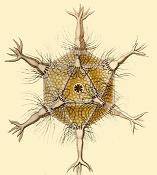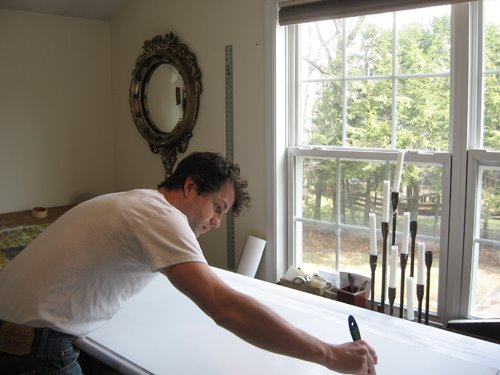Friday, June 27, 2008
Thursday, June 26, 2008
Wednesday, June 25, 2008
what I am reading
 I bought this book yesterday and finished it. It is hilarious and a must -read for those who still actually open these musty things called books. Most artists cannot write, in fact, most artists do little aside from sit in cafe's and talk and smoke. as dumb as most artists are they are generally smart enough to hide what they are not good at so they work on a single skill until the become passable and if they are lucky perhaps they can coax a golden egg from the goose of their labor. I have met very few artists who know how to swim in the sea of words. Dali was a masterful writer and he had a great wit about him. I find his humor at its best as he pokes fun at other artists...e.g calling Matisse a painter of seaweed etc etc. Dali was a polymath in the first degree and his mind is worth dissecting because he had some very valid insights into the con-game that is modern art.
I bought this book yesterday and finished it. It is hilarious and a must -read for those who still actually open these musty things called books. Most artists cannot write, in fact, most artists do little aside from sit in cafe's and talk and smoke. as dumb as most artists are they are generally smart enough to hide what they are not good at so they work on a single skill until the become passable and if they are lucky perhaps they can coax a golden egg from the goose of their labor. I have met very few artists who know how to swim in the sea of words. Dali was a masterful writer and he had a great wit about him. I find his humor at its best as he pokes fun at other artists...e.g calling Matisse a painter of seaweed etc etc. Dali was a polymath in the first degree and his mind is worth dissecting because he had some very valid insights into the con-game that is modern art.
Projects rundown
1) a 90 foot glass wall of carved birch trees (for a hotel.)
2) a mirror of carved orchids for veniero's pastries.
3) a carved art deco skylight for a private party space in NYC.
4) an illustration of an angel for realms of Fantasy magazine.
5)my ongoing "barter project"
6) a painting --eyes of texas (in progress)
more on Radiolaria and the Platonic Solids
The tetrahedron, cube, and octahedron all occur naturally in crystal structures. These by no means exhaust the numbers of possible forms of crystals. However, neither the regular icosahedron nor the regular dodecahedron are amongst them. One of the forms, called the pyritohedron (named for the group of minerals of which it is typical) has twelve pentagonal faces, arranged in the same pattern as the faces of the regular dodecahedron. The faces of the pyritohedron are, however, not regular, so the pyritohedron is also not regular.

In the early 20th century, Ernst Haeckel described (Haeckel, 1904) a number of species of Radiolaria, some of whose skeletons are shaped like various regular polyhedra. Examples include Circoporus octahedrus, Circogonia icosahedra, Lithocubus geometricus and Circorrhegma dodecahedra. The shapes of these creatures should be obvious from their names.
Many viruses, such as the herpes virus, have the shape of a regular icosahedron. Viral structures are built of repeated identical protein subunits and the icosahedron is the easiest shape to assemble using these subunits. A regular polyhedron is used because it can be built from a single basic unit protein used over and over again; this saves space in the viral genome.
In meteorology and climatology, global numerical models of atmospheric flow are of increasing interest which employ grids that are based on an icosahedron (refined by triangulation) instead of the more commonly used longitude/latitude grid. This has the advantage of evenly distributed spatial resolution without singularities (i.e. the poles) at the expense of somewhat greater numerical difficulty.
Viva gardega (and plato)

 This morning I got up at my usual 4AM and went onto the internet and started my usual research into art and science. It is rare that I get as excited as I did today when I came upon a great revelation of glass shattering importance. I have always (as you may Know) been fascinated by the platonic solids and by the works of Plato and especially his inquiry into platonic solids of which I do not need to explain here except to say that they are pictured above and the top right solid is the icosahedron. Scientists are just now coming to the conclusion of something I suspected for a long time is that the atoms of glass are actually "stacked" in icosahedron shapes--- that means never really fit together very well. I learned about this by my inquiry into Radilolaria (of which I have carved many a Radiolaria in glass) in order to better understand their structure-see above glass carving from 1999...and so it goes..I hope I explained this sufficiently--read on
This morning I got up at my usual 4AM and went onto the internet and started my usual research into art and science. It is rare that I get as excited as I did today when I came upon a great revelation of glass shattering importance. I have always (as you may Know) been fascinated by the platonic solids and by the works of Plato and especially his inquiry into platonic solids of which I do not need to explain here except to say that they are pictured above and the top right solid is the icosahedron. Scientists are just now coming to the conclusion of something I suspected for a long time is that the atoms of glass are actually "stacked" in icosahedron shapes--- that means never really fit together very well. I learned about this by my inquiry into Radilolaria (of which I have carved many a Radiolaria in glass) in order to better understand their structure-see above glass carving from 1999...and so it goes..I hope I explained this sufficiently--read onglass--liquid or solid?

Being an artist who has spent twenty years exploring the possibilities of glass as an art form and one who knows the importance of such great artists as Tifanny and Lalique I have always been fascinated by the properties of this wonderfully fragile substance. I have always known that glass is actually a "slow liquid" and that in time windows actually "seep down" and get thicker at the bottom as in old homes and churches. Glass is like not unlike the artist Jackson Pollock in that no matter how hard he tried he could never draw or paint very well and by this I mean glass no matter how hard it tries it can never become a true solid. If you are an artist you must "know thyself" (in a socratic sense) and if you are neither fish nor fowl you will never rise to the challenge of making good art that will last longer than a frog on the jersey turnpike. Here is some more fascinating news regarding a groundbreaking discovery in the study of glass and what it can mean for the future of art and non-art.
Icosahedron jams
Some materials crystallize as they cool, arranging their atoms into a highly regular pattern called a lattice, Royall said, but although glass "wants" to be a crystal, as it cools the atoms become jammed in a nearly random arrangement, preventing it from forming a regular lattice.
In the 1950s, Sir Charles Frank in the Physics Department at Bristol suggested that the arrangement of the "jam" should form what is known as an icosahedron, but at the time he was unable to prove it.
An icosahedron is like a 3-D pentagon, and just as you cannot tile a floor with pentagons, you cannot fill 3-D space with icosahedrons, Royall explained. That is, you can't make a lattice out of pentagons.
When it comes to glass, Frank thought, there is a competition between crystal formation and pentagons that prevents the construction of a crystal.
If you cool a liquid down and it makes a lot of pentagons and the pentagons survive, the crystal cannot form.
It turns out that Frank was right, Royall said, and his team proved this experimentally.
You can't watch what happens to atoms as they cool because they are too small, so Royall and his colleagues used special particles called colloids that mimic atoms, but are large enough to be visible using state-of-the-art microscopy.
The team cooled some down and watched what happened.
What they found was that the gel these particles formed also "wants" to be a crystal, but it fails to become one due to the formation of icosahedra-like structures — exactly as Frank had predicted.
"It is the formation of these structures that underlie jammed materials and explains why a glass is a glass and not a liquid — or a solid," Royall said.
The findings are detailed in the June 22 issue of the journal Nature Materials. The research was supported in part by a grant from Britain's Ministry of Education, Culture, Sports, Science and Technology as well as the Royal Society.
Tuesday, June 24, 2008
mcsorleys painting
Monday, June 23, 2008
photo of the day

My friend Rebbecca took this photo from her apt. in NPT long island. There was a big storm and/ or tornado that tore through and did some damage. As a child in Texas I saw a lot of tornadoes and these clouds have that same ominous color and feel that would swell up before a twister touched down. I think I will paint an oil from this photo soon. This reminds me of work of the painter Courbet.
Mcsorleys painting on Ebay
buy it here:
http://cgi.ebay.com/ws/eBayISAPI.dll?ViewItem&item=290240825025&ssPageName=ADME:L:LCA:US:1123
Sunday, June 22, 2008
mcsorleys update
moon illusion
 Many people think that the moon is actually larger or closer just as it just "breaks the horizon." Or that it is larger when it is closest to the horizon ---- Being a science buff and man without a TV I am able to spend time figuring things out that do not really matter. The moon is not larger as it breaks the horizon this is an illusion. For further inquiry click on the link below...
Many people think that the moon is actually larger or closer just as it just "breaks the horizon." Or that it is larger when it is closest to the horizon ---- Being a science buff and man without a TV I am able to spend time figuring things out that do not really matter. The moon is not larger as it breaks the horizon this is an illusion. For further inquiry click on the link below...http://science.nasa.gov/headlines/y2008/16jun_moonillusion.htm?list65200






